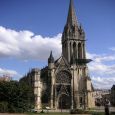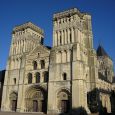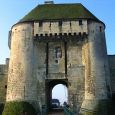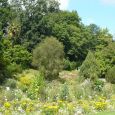Caen
Advertisement
By train
Trains leave about every 2 hours from Paris Saint-Lazare station to Caen and Cherbourg. It lasts about 2 hours long, costs 29,10 € (full price). If you book early, you can get tickets as cheap as 15 €. Out of rush hours, tickets cost 22,40 € for people under 25 years-old.
Note that the train posting in Paris St-Lazare can be confusing to the first time traveler. The train line number ("la voie") is not posted unil 15-20 minutes before the departure, so do not panic if you arrive earlier than that (notice that the train will be at a line number near to the office "Grandes Lignes"). Look for the train heading to Cherbourg. Caen will not be the listed destination, as it is a stop along the way. Do not forget to punch ("composter") your ticket in one of the yellow machines before boarding. This will validate your ticket.
By car
from Paris, by A13 motorway (2 hours) (toll).
from Cherbourg by N13.
from Rouen, by A13 or N175 (toll).
from Rennes by A84.
from Tours and Le Mans, by N138, via N158 at Sées.
By ferry
Ferries cross the Channel from Portsmouth (UK) to Ouistreham, 15 km north of Caen.
Caen Castle
The Chateau de Caen is a castle in the French town of Caen in the Calvados departement (Basse-Normandie). It has been officially classed as a Monument historique since 1886.
The castle was built circa 1060 by William the Conqueror, who successfully conquered England in 1066. His son Henry I then built the Saint Georges church, a keep (1123) and a large hall for the Duke CourtAt Christmas 1182 a royal court celebration for Christmas in the aula of Caen Castle brought together Henry II and his sons, Richard the Lionheart and John Lackland, receiving more than a thousand knights.
Abbaye aux Dames
The Abbaye aux Dames is a former abbey in Caen, Normandy, northern France, now home to the Conseil Régional de Basse Normandie . It includes the church now known as the Église de la Sainte Trinite.The abbey was founded in the late 11th century by William the Conqueror and his wife Matilda as the Abbaye aux Dames ("Abbey of Women"), together with Abbaye aux Hommes ("Abbey of Men"), now church of Saint Etienne. The works began in 1062, starting from the rear and finished in 1130. Matilda, who died in 1083, was buried in the choir under a slab of black marble.
Botanical Garden Caen
The Jardin botanique de Caen, more formally known as Le jardin des plantes et le jardin botanique de Caen, is a botanical garden and arboretum located at 5, place Blot, Caen, Calvados, Basse-Normandie, France. It is open daily.The garden's earliest plants were collected in 1689, and its first catalog published in 1781. It was established on the site of an old stone quarry as a university botanical garden, but in 1803, after the French Revolution, it was extended by 3.5 hectares to become a municipal park. In 1860 two large greenhouses were constructed, and a botanical institute added in 1891, but all were destroyed in World War II. New greenhouses were built in 1988.
Church of Saint-Pierre
The Church of Saint-Pierre is a Roman Catholic church dedicated to Saint Peter situated on the Place Saint Pierre in the center of Caen in Normandy, northern France.The construction of the present building took place between the early 13th and the 16th centuries. The spire was destroyed in 1944, and has since been rebuilt.The eastern apse of the church was built by Hector Sohier between 1518 and 1545 [1]. The interior choir and the exterior apse display an architecture that embodies the transition from Gothic to Renaissance.
Abbaye-aux-Hommes
The Abbaye aux Hommes ("Men's Abbey") is a former abbey church in the French city of Caen, Normandy. Dedicated to Saint Stephen ("Saint Étienne"), it is considered, along with the neighbouring Abbaye aux Dames ("Lady's Abbey"), to be one of the most notable Romanesque buildings in Normandy. Like all the major abbeys in Normandy, it was Benedictine. Lanfranc, before being archbishop of Canterbury, was the abbot of Saint-Etienne.
Information not available






